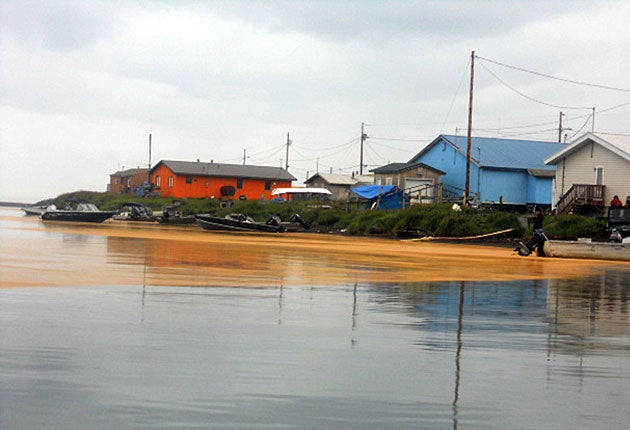Mysterious orange goo leaves Alaskan villagers baffled

Your support helps us to tell the story
From reproductive rights to climate change to Big Tech, The Independent is on the ground when the story is developing. Whether it's investigating the financials of Elon Musk's pro-Trump PAC or producing our latest documentary, 'The A Word', which shines a light on the American women fighting for reproductive rights, we know how important it is to parse out the facts from the messaging.
At such a critical moment in US history, we need reporters on the ground. Your donation allows us to keep sending journalists to speak to both sides of the story.
The Independent is trusted by Americans across the entire political spectrum. And unlike many other quality news outlets, we choose not to lock Americans out of our reporting and analysis with paywalls. We believe quality journalism should be available to everyone, paid for by those who can afford it.
Your support makes all the difference.A neon orange goo that appeared in a remote Alaskan village last week has scientists baffled.
The 347 residents of the tiny hamlet of Kivalina, one of the most hard-to-reach outposts of the United States, have been boiling their water while they await answers from labs in the state capital, Anchorage, and in the continental US, where they have sent samples from the local lagoon.
Lakes, ponds, puddles and even buckets collecting rainwater in residents' backyards all developed a thin film of the substance after rain showers last week.
"It was really light, a powdery look to it, and it was just floating on there, all bunched up together," said Austin Swan, who waded out into the lake to scoop up the material. "It looked like it could blow away very easily."
Some of the material had a sheen to it, like it was oil, he said, "but I couldn't feel the oil at all, any texture at all".
Kivalina's village elders reported that nothing like it has been seen in the region's history.
The village is an Inupiat Eskimo outpost located at the tip of an eight-mile barrier reef on Alaska's northwest coast, between the Chukchi Sea and Kivalina River to the north and the Wulik River to the south. Most of the residents are subsistence farmers, fishing, hunting caribou and gathering berries, and their concern is that their livelihoods could be affected if the substance proves to be toxic.
The local coast guard, however, has ruled out the possibility that the substance is a petroleum-based residue somehow connected to the state's lucrative oil and gas industry, and instead is working on the theory that it could be an unusual kind of algae.
"There doesn't appear to be any evidence of a release of oil or hazardous substances at this time, but we're continuing to investigate and trying to get lab determinations on what exactly the material is," Emanual Hignutt, analytical chemistry manager for Alaska's Environmental Health Laboratory told CNN. "What it is – an algal bloom, or something inorganic – that's what we're working to get some more information on."
The substance was first spotted floating in the town's harbour, but was also reported in a river 150 miles away.
A day after the initial discovery, following a downpour, Kivalina residents found the orange matter floating on top of rain buckets they use to collect drinking water. It was also discovered on one roof, leading them to believe it was airborne.
When the material bunched up in the lagoon, it created 10ft-by-100ft swaths of glimmering orange, Frances Douglas told an Associated Press reporter.
"When the wind came in, it narrowed them to a few feet wide. The colour was a bright neon orange. It pretty much covered the south end of the lagoon in streaks. Everybody was baffled."
By Friday the substance appeared to have dissipated, but it left behind a powdery residue that is still worrying the residents. Children have been told to keep away, and the town is boiling its limited water supplies – just in case.
Join our commenting forum
Join thought-provoking conversations, follow other Independent readers and see their replies
Comments